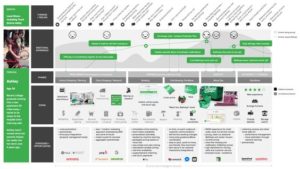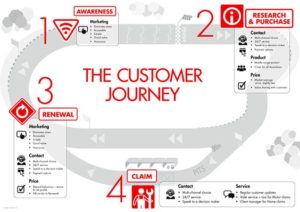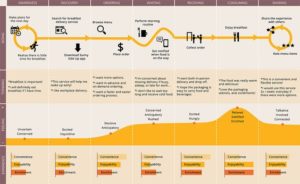Podcast: Play in new window | Download (5.9MB)
Subscribe: Apple Podcasts | TuneIn | RSS | More
This CX Mini Masterclass is the third of a 3-part installment on the topic of the customer journey mapping. Building on the insights from parts 1 and 2, show host and CX expert Julia Ahlfeldt explores best practices for how to map the customer journey. She shares practical ideas for how to keep teams focused while leaving space for creativity as you map the journey. This episode will set you on the path to leading a great journey mapping session that will foster buy-in and support for customer-centric change.
Creating the mosaic
Journey mapping is like creating a mosaic. When you think about how to map the customer journey, approach it as a process of bringing together lots of different pieces of information to create a bigger picture. The key is to understand both the bigger picture that you are aiming for and the “tiles” that you’ll need to gather to create your mosaic. (Incidentally, most team use post-it notes to gather information, so I find that the mosaic/tile analogy works quite well as a way to explain the process to team members.) As the smaller pieces of information come together, the map will begin to take shape and the “picture” will emerge. You may want to adjust your vision of the output as things evolve, but it is really helpful to start with some idea of the desired end result.
The very first step is to identify the type of map that you are aiming for (if not, check out episode 18 which covers the different types of maps, as this step is key to the success of your mapping efforts). Once you’ve done this, think about how your map will be used and what visual representation will be most useful for your team. There are so many different formats, and no single right answer, so look for examples that will resonate with your audience and fulfill the desired use of the map.
As an example of the inspirations that you can easily find, here are several sample maps that I found online:
These maps are quite different, and would have distinct uses. Whichever map you choose, remember to keep it simple and always positioned from the customer’s perspective.
Gather your mosaic tiles
Once you have a vision for your map, understand what types of information you’ll need to gather. These are your mosaic tiles. Again, this needs to align with the intended use of you map, but common types of information often include customer actions, emotions, sentiments, touch points, moments of truth, expectations, outcomes, etc.
I often start by creating a grid layout with the journey phases at the top and the information categories on the vertical axis, as a framework to start gathering and categorizing your journey data. If you are unsure about how to create this layout, don’t worry! I’ve provided a sample template that you can download and use as a guideline for mapping.
Click here to download my journey mapping template
Tips for how to map the customer journey
Once you have your plan in place, it’s time to engage with teams and make the journey mapping happen. Here are some tips and suggestions for how to make this engagement as successful as possible.
- Provide clear direction – Give your colleagues some structure to work with, and be there to gently guide them back on track when they start looking at things from the business’ point of view. This will happen.
- Give creative licence – Allow team members to be creative and be flexible with how the map may evolve as your colleagues provide input
- Share customer insights – Make sure that you have customer insights at the ready and that your persona and empathy map are front-and-center as a reminder of the lens through which the journey should be developed
- Assemble the right supplies – Set the stage for journey mapping and make sure that you have plenty of post-it notes, markers, paper, whiteboard space, etc.
- Have fun! – All work and no play makes for a boring journey map. This is your time to engage teams with the customer, so all the better if you can make this an enjoyable experience.
It’s easy to get overwhelmed when figuring out how to map the customer journey, especially if this is your first time making a map. Journey maps are living documents and should evolve with the needs of customers. Enjoy the process and don’t lose your way in the pursuit of perfection.
Want to keep learning about CX?
If you’d like to checkout more of these CX Mini Masterclasses or listen to my longer format CX expert interviews, check out the full listing of episodes for this CX podcast.
And if you are looking to super-charge your CX skills and continue learning, be sure to check out CX University. They have a great array of CXPA accredited training resources available on a flexible monthly subscription plan. Use the code PODCAST10 to get 10% off your first month’s subscription and support this podcast.
Decoding the Customer is a series of customer experience podcasts created and produced by Julia Ahlfeldt, CCXP. Julia is a customer experience strategist, speaker and business advisor. She is a Certified Customer Experience Professional and one of the top experts in customer experience management. To find out more about how Julia can help your business achieve its CX goals, check out her customer experience advisory consulting services (including journey mapping workshops!) or get in touch via email.


